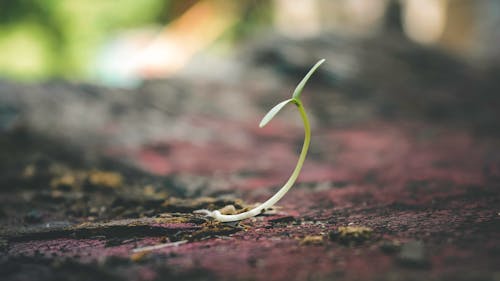The sunflower plant contains hormones called auxins. These hormones are touchy to sunlight. Therefore, they move from the piece of the plant exposed to daylight to the shadow area in the stem. Once there, the auxins (which are basically development hormones) animate the development of cells. This makes the stem become bulkier in the concealed locale, so the bloom winds up twisting the other way towards the Sun. There is a culture of sunflower seed admirers. Tragically the oil in sunflowers is omega-6, which causes aggravation in the body. You have to take a gander at all of the fats you devour and they ought to be the solid fats that our body needs: omega-3 unsaturated fats in nuts, peanuts (a vegetable), coconut oil with medium-unsaturated fats, olive oil, avocado. Stay away from the awful fats like omega-6 unsaturated fats (canola, grape seed, safflower seed oils, soybean oil, sunflower oil) that cause joint inflammation, and cardiovascular illness, which you need to maintain a ...

SO, HOW CLOSE ARE WE TO DISCOVERING ALL LIFE ON EARTH? IN THIS EPISODE, WE’LL MEET SOME AMAZING BIODIVERSITY RESEARCHERS WORKING INTERNATIONALLY TO ACCELERATE SPECIES DISCOVERY, DEVELOP DIGITAL CONSERVATION TOOLS, AND MAINTAIN ONE OF THEWORLD’S LARGEST BIOLOGICAL COLLECTIONS THROUGH A PROCESS CALLED “CRYOPRESERVATION” THAT IS, LITERALLY, ULTRA-COOL. BUT THIS NETWORK OF RESEARCHERS HAS A HERCULEAN EFFORT IN FRONT OF THEM. - Strangely enough, we know only maybe 10%of the biodiversity that we have on our planet.
THAT MEANS THERE’S SOMETHING LIKE 90% OF LIFE ON EARTH LEFT TO DISCOVER. SO LET’S START AT THE BEGINNING. DESCRIBING A NEW SPECIES TYPICALLY REQUIRESCOLLECTING A PHYSICAL SPECIMEN OF SOME KIND, WHICH CAN OFTEN MEAN TRAVELING TO HARD-TO-REACH LOCATIONS. - They call them these ”rapid inventories.”Sometimes they don't have road access so they'll fly in by plane and just parachute in with a team of ecologists that identify the plants, the birds, the amphibians, and the butterflies. - If a species is bigger, it's easier to find than a small specimen. If the species has a colorful pattern, it's easier to see than a species that has a kind of camouflage.
ONCE IT’S RETRIEVED, THE SAMPLE WILL BE SENT TO A SCIENTIFIC COLLECTION, WHERE IT MAY HAVE TO WAIT TO BE DISCOVERED ALL OVER AGAIN. After you collect this specimen in nature, it might take, like, 21 years for that specimen to be discovered in a scientific collection, and have someone process it and describe it as a formal new species.
THIS IS BECAUSE THE EXPERTISE REQUIRED TODO THIS IS PRETTY RARE. A TAXONOMIC EXPERT NEEDS TO STUDY THE SPECIES’SHAPE, STRUCTURE, AND GENETIC MAKEUP, AND COMPARE IT WITH ANY CLOSE KNOWN RELATIVESBEFORE GIVING IT A NAME. We don't have enough taxonomists. We need to have an army of taxonomists to describe all the species that exist in the world.
BUT DUBBING A SPECIES OFFICIAL IS JUST THE BEGINNING. TO CREATE A RECORD OF IT THAT OTHER SCIENTISTSCAN STUDY, LET ALONE USE FOR ANY CONSERVATION WORK, WE NEED TO CAPTURE AND PRESERVE ALLTHE INFORMATION WE CAN ABOUT AN ORGANISM. THAT’S WHERE COLLECTIONS LIKE THE SMITHSONIAN INSTITUTION’S BIOREPOSITORIES COME IN. SO WE WENT TO VISIT THE NATIONAL ZOO IN DOWNTOWN WASHINGTON, D.C. TO SEE WHAT HAPPENS NEXT. - A biorepository is a specialized facility that really contains a lot of biological materials, that really need to be preserved in a stable state. It's like in a museum when you have paintings that are very sensitive to the variation of humidity or temperature. Every day, we have tens to hundreds of incoming samples that are processed and stored for the long term. I would say that we are probably among the largest collections in the world.
THAT COLLECTION REPRESENTS AROUND 18,000 SPECIES AND INCLUDES OVER 1 MILLION DNA SAMPLES, SKIN BIOPSIES, BLOOD SAMPLES, SPERM, EGGS, EMBRYOS... YOU NAME IT. CRYOPRESERVATION INVOLVES A SERIES OF METICULOUS STEPS, WHICH I GOT TO EXPERIENCE FIRSTHAND. THE WATER IN A SKIN SAMPLE FROM A NEWLY DISCOVERED RODENT, FOR EXAMPLE, NEEDS TO BE REPLACED WITH A FLUID CALLED CRYOPROTECTANT THAT ACTS AS ANTIFREEZE, EFFECTIVELY PUTTING THE CELLS ON PAUSE WHEN THE SAMPLE IS STORED IN LIQUID NITROGEN. So basically you suspend life entirely and this life suspension can travel through time- for a long, long period of time. - Do you mind if I try? Is that okay? - Sure, go for it. - You have to show me how to do it, though, because I have a feeling this is harder than it looks. - A little. - Okay. So, we’ve got the… things… and the goal is to put it in the tube, right? Okay. - Mm-hmm, and while keeping everything underneath the liquid nitrogen, as much as possible. - Haha, I don’t know if I’m going to be able to do that, okay. Let’s try. Ah! Okay, okay. Like this... it’s not submerged, it’s not submerged… oh no. Ha! It’s good, right? - Nice! Yaaaaaaas. High five. We preserve also, all the packaging of the DNA but we also preserve the cells that are containing the DNA and beyond the cells, the whole tissue. We want to make sure that everything is still viable when we are thawing the samples. Viable means that the tissue has to be able to recover and to resume normal activities, biochemical, biophysical activities, and when we are talking about gonadal tissues like ovaries or testes, we need to make sure that they are still producing germinal cells.
YOU HEARD THAT RIGHT – THESE SAMPLES CAN BE USED NOT ONLY FOR FUTURE SCIENTIFIC STUDY, BUT EVEN ARTIFICIAL INSEMINATION TO HELP RECOVER AN ENDANGERED POPULATION. AND WHILE THE ZOO ITSELF SPECIALIZES INVERTEBRATES AND CARNIVORES, THROUGH SOMETHING CALLEDTHE “PAN-SMITHSONIAN CRYOINITIATIVE,” PIERRE AND HIS TEAMWORK WITH SCIENTISTS AT OTHER ZOOS, MUSEUMS, AND RESEARCH CENTERS TO PRESERVE INVERTEBRATES, PLANTS, AND SOIL SAMPLES, ADDING MICROBES AND FUNGI TO A MORE AND MORE COMPLETE ‘LIBRARY OF LIFE.’ - So, there are specific parts of the planet that we've barely explored, and there are specific parts of the tree of life, like specific animal groups, that we haven't scientifically explored in the same way.
SO HOW DO WE KNOW WHERE TO LOOK NEXT? WHERE MIGHT BE MOST AT RISK, OR MOST RIPE FOR DISCOVERIES? TO CREATE A ROADMAP THAT POINTS US TO WHERE NEW SPECIES MIGHT BE HIDING, WE’LL NEED TO COMPILE EVERYTHING WE KNOW SO FAR ABOUT WHERE SPECIES OCCUR, FROM CONSERVATION DATASETS, TO VINTAGE FIELD GUIDES, TO INFORMATION COLLECTED BY CITIZEN SCIENTISTS ON THEIR MOBILE PHONES. ENTER THE “MAP OF LIFE,” A FLAGSHIP PROJECT AT YALE’S CENTER FOR BIODIVERSITY AND GLOBAL CHANGE THAT’S DOING JUST THAT. What we do is compile all types of spatial and non-spatial information about species, to get the best idea of where species occur in the world. Our data teams can standardize millions of records so that we can really easily and quickly get an idea of, ‘this is what information we have for this specific region.’
AS THE NAME SUGGESTS, THIS DATA, TAKEN TOGETHER, CREATES A VIRTUAL MAP OF LIFE THAT CAN BE USED BY ANYONE, WHETHER YOU'RE DISCOVERING SPECIES IN YOUR OWN BACKYARD OR PLANNING A FIELD EXPEDITION. We also inform UN-level decision-makers and conservation managers that are working on the ground. It gives an answer to people that are curious to say like, "how can I get involved? How can I help?" And this is showing like, "This is what you'restewarding in your area that you live." Anywhere on the planet.

BUT WHETHER RACING TO FREEZE TISSUE SAMPLES THAT IMMORTALIZE A SPECIES OR DRAWING DIGITAL MAPS THAT POINT US TO NEW DISCOVERIES, RESEARCHERS AGREE THAT OUR BEST BETTO PRESERVE AND DOCUMENT LIFE AS QUICKLY AS WE CAN, IS TO ACT LOCALLY AND THINK GLOBALLY. We built a dashboard for Peru, Ecuador, and Columbia for park managers there to figure out what species are in their park, what do we expect to be there, and also what has been actually recorded there. In some cases, a species only occurs in one smaller reserve, and nowhere else on the planet. And many times the park manager doesn't know that. So it's making these really important linkages for them to be able to make decisions at a really small scale. - We've been working extensively with Thailand, with Vietnam. We've been working with countries like Kuwait in the Middle East. To build capacity and to help countries to build their own national gene bank to make sure that they preserve their own biodiversity. - The regions with the most rewarding potential to have new discoveries are the tropical forests. They harbor most of the undescribed species on Earth, amphibians, reptiles, birds, and mammals.
SO, IF ALL WE NEED TO DO IS PRESERVE OUR TROPICAL FORESTS, RECRUIT AN ARMY OF TAXONOMISTS TO EXPLORE THEIR LIVING TREASURES, CLEAN OUT THE SHELVES OF OUR SCIENTIFIC COLLECTIONS TO SEE WHAT MIGHT BE HIDING IN PLAIN SIGHT, AND POUR MORE RESOURCES INTO PRESERVING AND PROCESSING MILLIONS OF SAMPLES AND DIGITAL RECORDS TO BUILD A LIBRARY OF LIFE AND A ROAD MAP THAT POINTS US TO NEW DISCOVERIES, HOW CLOSE ARE WE TO DISCOVERING ALL LIFE ON EARTH? - In birds, in mammals, we have a piece of better knowledge. In amphibians and reptiles, that knowledge is not that good, but it's something at least. But for invertebrates and marine organisms, that knowledge is really sparse. At the current rate of discoveries, it might well take 50 years to describe all vertebrates. So the other groups, like invertebrates or marine organisms - I would say that it will take perhaps another 100 years. Or more. - When you think that there are millions of species on the planet and when I tell you that we only have 18,000 in the biorepositories at the Smithsonian, you can see that it's a very small proportion. But when you think about it, I mean, everything grows exponentially. Because 100 years ago, we had no idea what cryobiology was. Ten years ago, we knew that we could sequence DNA but it was a very, very long process and now it can be done in an hour for a single genome. It's a transgenerational, multi-generational effort and I think it's pretty encouraging to know that there are good chances for those efforts to be carried on, and probably improve, and go way faster than what we can do right now. - When you're working in biodiversity conservation, it's easy to lose hope because you're just seeing we're in a mass extinction crisis. But we're in this age where technology can really change the landscape of how we operate, in positive ways. So I have a lot of hope that it's not too late, and now is as good a time as any to do something about it. For a complete guide to all things science, subscribe to Seeker. And let us know in the comments below what we should investigate next. This was actually a really special episode for me because it was my first time getting to travel with Seeker, go in a lab, and investigate what the scientists were doing in real-time, so if you like that please leave it in the comments below, thumbs up and share this video. Thanks so much for watching.Bye!
Comments
Post a Comment